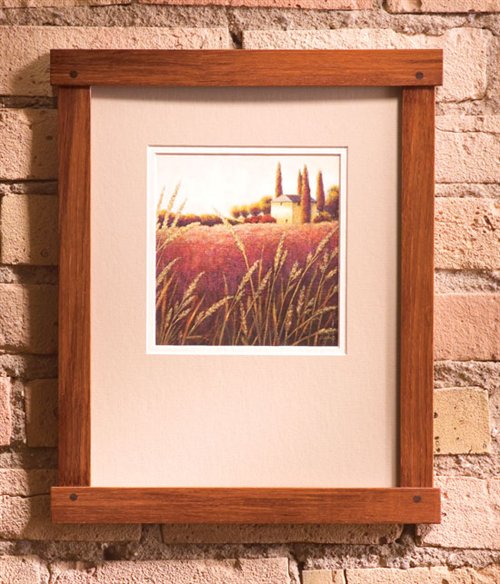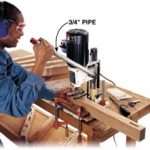We may receive a commission when you use our affiliate links. However, this does not impact our recommendations.
Craftsman Frame
Pegged half-lap joints are the cabinetmaker’s way to build a beautiful frame.
By Jock and Susan Holmen
| Picture frames are pretty easy to make, except when it comes to putting the pieces together. Getting four mitered corners perfectly cut and glued can drive you batty! This frame uses a simpler approach—the half-lap, a traditional furniture maker’s joint. It’s very easy to make on the tablesaw and resembles a much more complicated mortise-and-tenon joint. |
You may also like… |
| If you’ve never made a picture frame or lap joint before, this is a great project to start with. And it’s easy to make a whole bunch of these frames at the same time. We’ll show you an optional goof-proof sled that helps make cutting dozens of joints simple, safe and accurate.
Our frame is teak, a wood whose rich golden color beautifully complements most photos or artwork. Using quartersawn white oak would also look striking. This is a traditional Arts and Crafts-style frame, and quartered oak was the preferred wood of that era. If you’ve got some 8/4 (2-in.) wood, you can make top-grade quartersawn pieces for this frame by ripping the board at an angle (see “Make Your Own Quartersawn Lumber,” below). We’ve sized the frame to fit precut matte and glass available at many craft stores, so you don’t have to cut your own. The matte is 11 x 14 in. and fits an 8 x 10-in. photo. You’ll need a stacking dado set for your tablesaw to make the lap joints. (A wobble-type dado set won’t work because it doesn’t cut a flat bottom.) You’ll also need a rabbeting bit for your router table (Photo 8). We recommend using a brad-point drill bit for the pegs that go into the frame’s corners (see Sources, page below). This bit makes a cleaner entry hole than a standard twist bit. The uprights, or stiles (A, Fig. A, below), of this frame are 5/8 in. thick. The cross pieces, or rails (B), are 3/4 in. thick. If you don’t have a planer to thin down pieces to 5/8 in., that’s not a problem. The pieces are so narrow that you can make them the right thickness on your tablesaw. Just stand some 3/4-in. pieces on edge and rip them to 5/8 in. Begin by cutting the stiles and rails to final width and length (see Cutting List, below). At the same time, make two extra stiles and two extra rails from an inexpensive wood to use as test pieces when you cut the joints. |
Click any image to view a larger version. |
| 5. Cut the second half of the dado only in a test piece. Move the stop block so the inside dado mark lines up with the left-hand cut in the sled. |  |
| 7. Glue the frame together. You don’t need much glue or clamping pressure. Spring clamps work fine, so you don’t have to worry about marring freshly sanded surfaces. Remove any squeezed-out glue with a sharp stick before the glue hardens. Wipe off the stick’s glue on a damp rag as you go. |  |
| 12. Fit the glass, matte, photo or art into the frame and secure with fasteners. For more information on installing these materials, see “How To Mount Artwork,” below. Attach hangers or eye hooks and wire onto the back of the frame. |
How to mount artworkHere’s how to expertly mount photos and artwork to protect them from moisture and damage. |
 |
Sources(Note: Product availability and costs are subject to change since original publication date.) Groff & Groff Lumber Co., groffslumber.com, 800-342-0001, 4/4 teak. The Wood & Shop Inc., woodnshop.com, 314-731-2761, 1/4-in.-dia. x 36-in. walnut dowel, #221077. Lee Valley Tools Ltd., leevalley.com, 800-871-8158, Veritas flush-cut saw, single edge, #05K34.01; 1/4-in. brad-point drill bit, #07J02.16. Woodworker’s Hardware, wwhardware.com, 800-383-0130, CMT 1/2-in.-shank rabbeting router bit set, #CMT835.501.11. PENCO Graphic Supply Inc., artsuppliesonline.com, 800-967-7367, Acid-free matte board, 32 x 40-in. sheets; Gummed frame/hinge-sealing tape, #LI533-0751; Darkroom gloves, #PGS. |
Cutting List |
Project Requirements |
Fig. A: Exploded View |
Fig. B: Dado Sled |
Fig. C: Half-Lap Joint |
Fig. D: Rabbet |
| This story originally appeared in American Woodworker January 2005, issue #112. |
Here are some supplies and tools we find essential in our everyday work around the shop. We may receive a commission from sales referred by our links; however, we have carefully selected these products for their usefulness and quality.






































